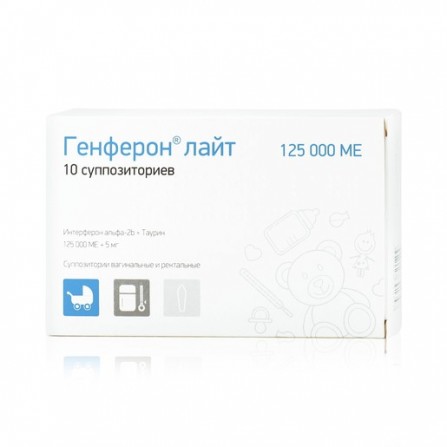Genferon Light Vaginal-rectal suppositories 125000me N10
Condition: New product
997 Items
Rating:
Be the first to write a review!

More info
Active ingredients
Interferon Alfa-2b + Taurine
Release form
Suppositories
Composition
Active ingredient: interferon alpha-2b - 125,000 IU; taurine - 0, 005 g; excipients: solid fat, dextran 60,000, macrogol 1500, polysorbate 80, emulsifier T2, sodium hydrocyte, citric acid, purified water - sufficient amount to obtain a suppository weighing 0, 8 g. Base volume: Suppository Concentration of active Substances (IU): 125 000 IU
Pharmacological effect
Combined medication, the action of which is due to the components in its composition. It has a local and systemic immunomodulatory effects. Interferon alpha-2 has antiviral, antimicrobial and immunomodulatory effects. Under the influence of interferon alpha-2, the activity of natural killer cells, T-helper cells, phagocytes, as well as the intensity of B-lymphocyte differentiation, increases. Activation of leukocytes contained in all layers of the mucous membrane ensures their active participation in the elimination of primary pathological foci and restoration of production of secretory immunoglobulin A. Interferon alpha-2 also directly inhibits the replication and transcription of viruses, chlamydia. Taurin has membrane and hepatoprotective, antioxidant and anti-inflammatory properties, enhances tissue regeneration. Benzocaine is a local anesthetic. Reduces the permeability of cell membranes for sodium ions, displaces calcium ions from receptors located on the inner surface of the membrane, blocks the conduction of nerve impulses. It prevents the appearance of pain impulses in the endings of the sensory nerves and their passage through the nerve fibers.
Pharmacokinetics
When vaginal or rectal administration, interferon alpha-2 is absorbed through the mucous membrane, enters the surrounding tissues, into the lymphatic system, providing a systemic effect. Also, due to partial fixation on the cells of the mucous membrane, it has a local effect. Reducing the level of serum interferon 12 hours after the administration of the drug necessitates its repeated administration.
Indications
As a component of complex therapy - for the treatment of acute respiratory viral infections and other infectious diseases of bacterial and viral etiology in children. For the treatmentinfectious and inflammatory diseases of the urogenital tract in children and women, including pregnant women.
Contraindications
Individual intolerance to interferon and other substances that make up the drug. I trimester of pregnancy. With care Exacerbation of allergic and autoimmune diseases.
Use during pregnancy and lactation
If necessary, the use of the drug in the II and III trimesters of pregnancy should relate the expected benefits to the mother and the potential risk to the fetus.
Dosage and administration
Dosage and administration
The drug can be used both vaginally and rectally. The route of administration, the dose and the duration of the course depend on the age, specific clinical situation and are determined by the attending physician. In adults and children over 7 years old, Genferon Light is used at a dose of 250,000 IU of interferon alfa-2b per suppository. In children under 7 years old, it is safe to use the drug at a dose of 125,000 IU of interferon alfa-2b per suppository. In women who are 13-40 weeks pregnant, the drug is used at a dose of 250,000 IU of interferon alfa-2b per suppository. Recommended doses and treatment regimens: Acute respiratory viral infections and other acute viral diseases in children: 1 suppository rectally 2 times a day with a 12-hour interval in parallel with the main therapy for 5 days. If symptoms persist, the course of treatment is repeated after a 5-day interval. Chronic infectious and inflammatory diseases of viral etiology in children: 1 suppository rectally 2 times a day with a 12-hour interval in parallel with the standard therapy for 10 days. Then within 1-3 months - 1 suppository rectally for the night every other day. Acute infectious and inflammatory diseases of the urogenital tract in children: 1 suppository rectally 2 times a day with a 12-hour interval for 10 days. Inflammatory infectious diseases of the urogenital tract in pregnant women: 1 vaginal suppository, 2 times a day with a 12-hour interval for 10 days. Infectious-inflammatory diseases of the urogenital tract in women: 1 suppository (250000 IU) vaginally or rectally (depending on the nature diseases) 2 times a day with a 12-hour interval for 10 days. With prolonged forms 3 times a week every other day, 1 suppository for 1-3 months.Side effects
The drug is well tolerated. Local allergic reactions are possible (sensation of itching and burning in the vagina). These phenomena are reversible and disappear within 72 hours after cessation of administration. Continuation of treatment is possible after consulting a doctor. To date, no severe or life-threatening side effects have been observed. Phenomena occurring when all types of interferon alfa-2b are used, such as chills, fever, fatigue, loss of appetite, muscle and headaches, pain in joints, sweating, and leuko- and thrombocytopenia, but more often they occur when the daily dose in excess of 10 000 000 IU. In these cases, it is recommended to consult the attending physician to decide whether to discontinue the drug or reduce the dose. As with any other drug interferon alpha, in the case of a temperature increase after its introduction, a single dose of paracetamol at a dose of 500-1000 mg for adults and 250 mg for children is possible.
Overdose
To date, cases of overdose Genferon drug have been reported.
Interaction with other drugs
When used together with antibiotics and other antimicrobial drugs used to treat urogenital infections, the effectiveness of Genferon increases. If used concurrently with vitamins E and C, the effect of interferon is enhanced. sulfonamides (due to the action of benzocaine).
special instructions
The drug should be used with caution in patients with allergic and autoimmune diseases in the acute stage.




